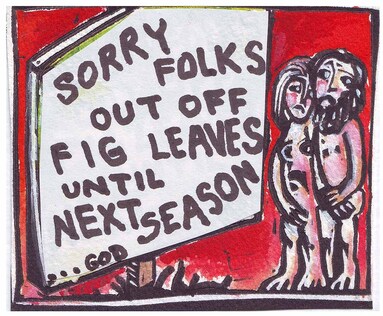 Cartoon by Natasha Williams-Novak
Cartoon by Natasha Williams-Novak THE fig tree, or Ficus Carica, is a species of flowering plant in the Moraceae family. One of the first cultivated fruit trees, it is said to have originated in Western Asia and from there was taken to the Mediterranean before reaching the rest of the world. There are over 700 varieties though many of these are ornamental. Sumarian stone tablets dated to 2500 BC depict its culinary uses. It has a historical association with wealth in Middle Eastern cultures and understandably so, given its ability to thrive and provide food in dry climates. Furthermore, by using no-carbon-footprint solar technology – or absence of technology – the fruit can be preserved and stored out of season in those hot, dry places.
Living for as long as one hundred years and attaining a height of up to 15 metres, though most varieties reach only 3 to 10 metres, left to its own devices it attains a spread greater than its height. Some varieties produce numerous root bearing suckers each year which can be removed to start new trees. The shallow water seeking roots can travel large distances and I've seen trees emerge 10 metres away from the main trunk after a root was cut with a shovel. The soft wood branches dry quickly and make handy kindling wood for the fire. On uncomfortably hot days, the canopy of this tree provides refreshingly cool shade, unlike some trees whose shade doesn't offer relief of heat beyond blocking direct sunlight. In the Bass Coast climate, the fruit begin to ripen at the end of summer or early autumn and the fruiting period lasts up to 6 weeks. There are several varieties in the area that ripen up to a month later.
Botanically speaking, the fig is not actually a fruit. It is described as an inflorescence, the complete flower head of a plant. It is also referred to as a syconium, a fleshy hollow receptacle that develops into a multiple fruit, making it the only so called fruit that contains the flower inside itself. It is effectively an inverted flower that blooms inside the syconium with all of the reproductive parts of the plant located inside the pod. Other fruit varieties begin with a blossom that has the latent fruit beneath it which emerges after pollination. I ran into some confusion in researching the pollination of figs. Some sources spoke of an arrangement between fig trees and certain species of wasp. When ready for pollination, the fig emits an aroma attracting female wasps of a specific type for that tree. They enter the fig via a small opening called an Ostiole, tearing off their wings in the process. Once inside, they lay their eggs and die,and an enzyme called ficin inside the fig digests their 1.5mm body. Therein, the larvae feed and grow, and the pollination process allows the many tiny flowers to turn into seeds. Some species are said to produce only female flowers and don't require pollination.
One method of preserving figs is to make jam. It’s not to everyone's liking, but some consider it to be an example of culinary excellence so good that it has become an acronym. From one point of view, FIGJAM – 'Expletive beginning with 'F' I'm Good Just Ask Me' – refers to a conceited person. The right of reply argues the case for someone not given to pretentious, even demeaning notions of false modesty who is unafraid and openly honest about singing their own praises and proclaiming their immense value and benefit to humanity. An Australian band, Butterfingers, have written a song about this subject.
The fig is highly regarded beyond the human family, enjoyed by many species of birds including chooks, along with rats and mice. This tree can indeed be justifiably considered a sign of wealth amongst those who value its fruit and those who value the First Invented G.